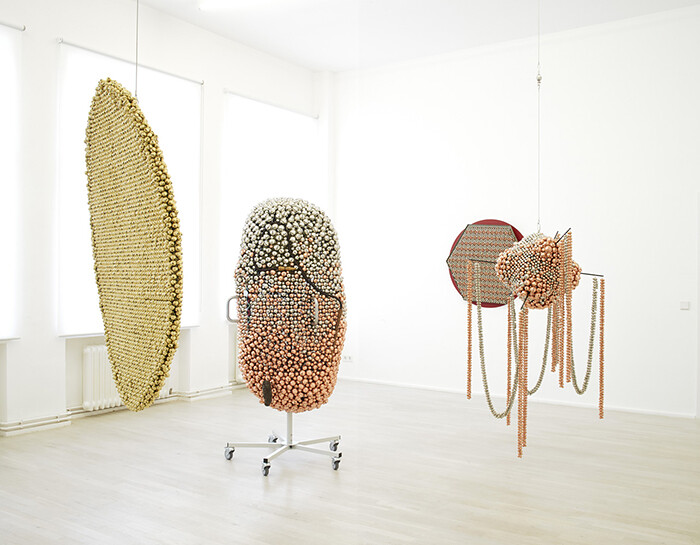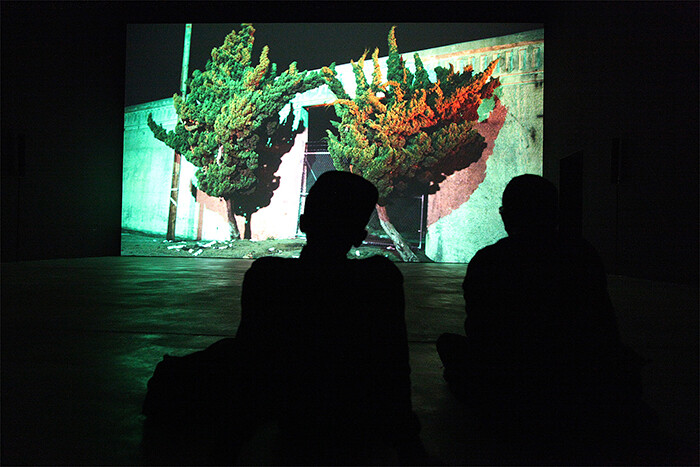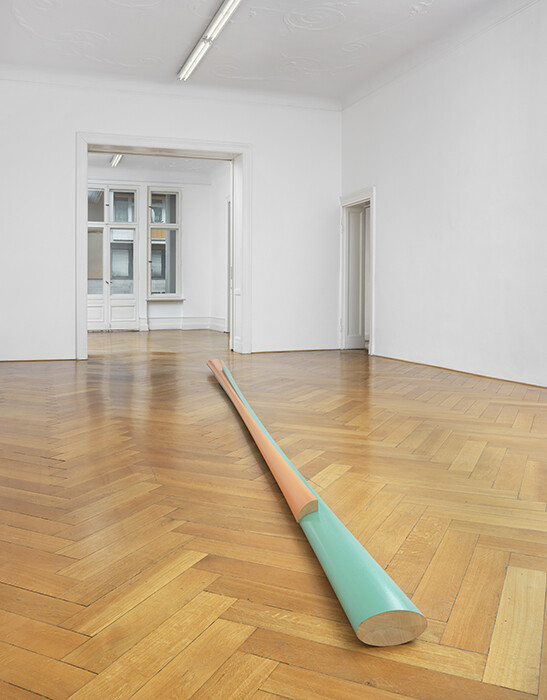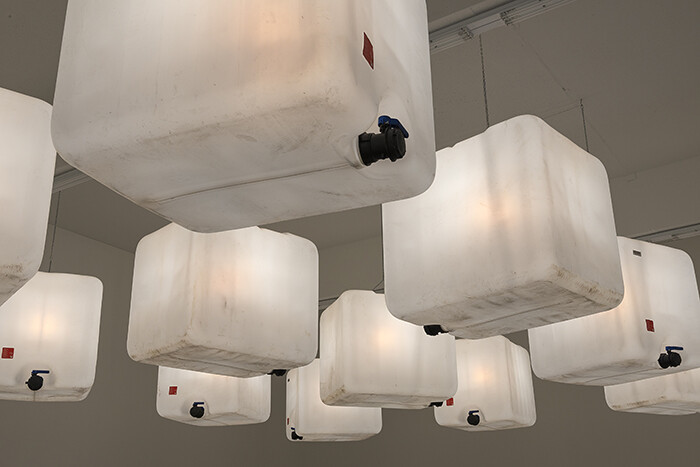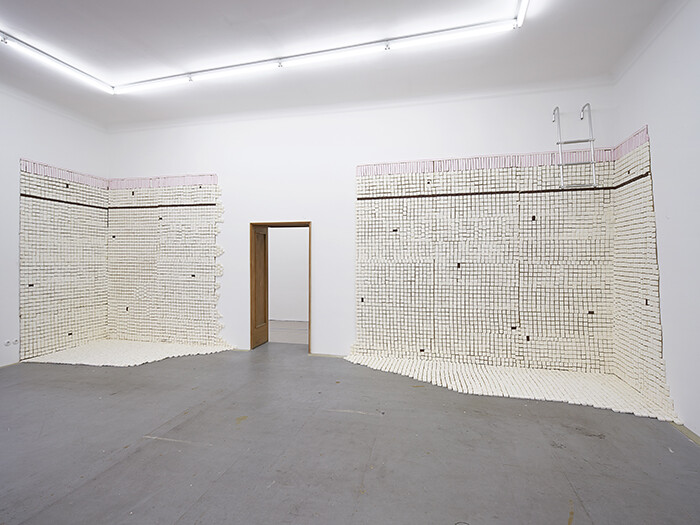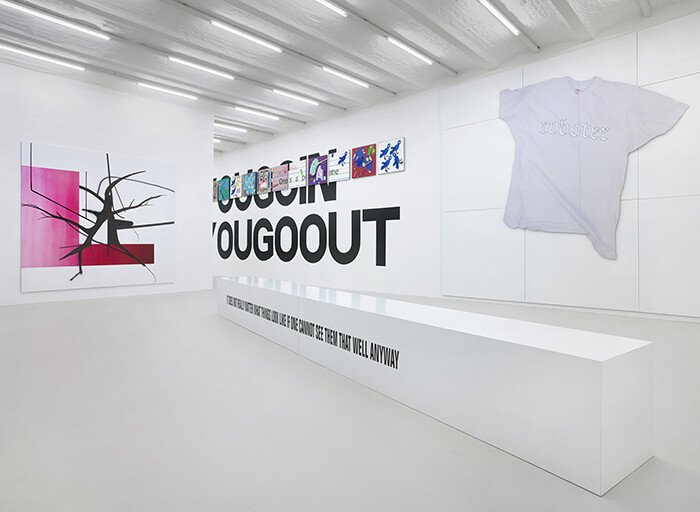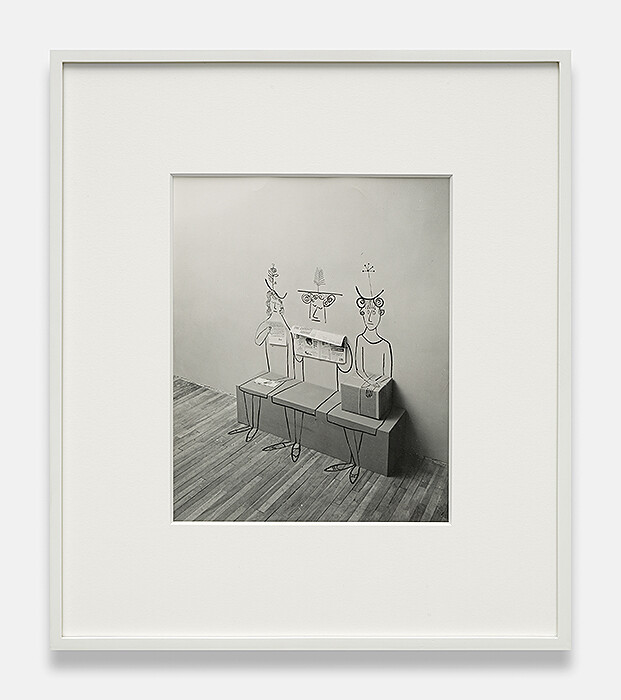Gallery Weekend arrives just as the first green leaves appear to relieve the city’s relentless gray. This is Berlin at its best: colorful, uncharacteristically cheerful, and ready to welcome the influx of art tourists for its annual weekend of openings and attendant festivities. This year a total of 47 galleries are on the official list, but a host of the additional exhibitions, performances, conferences, and talks, all maddeningly crammed into a three-day period, makes the weekend denser than ever. The choices of what to see and what to skip become ever more critical. Haegue Yang’s endearing jingle bell sculptures at Wien Lukatsch? Tino Sehgal’s songstress ensconced in a flower garden at Johnen Galerie? Cyprien Gaillard’s nighttime forays in seductive 3D splendor at Sprüth Magers?
The result of such a jam-packed weekend is inevitably a list of things missed as well as things seen: I didn’t make it to “Ngorongoro,” a rambling exhibition of over 100 artists in a studio complex in the northern district of Weissensee; or the conference on the current “Zero” exhibition at the Martin-Gropius-Bau, which boasted an impressive lineup of high-caliber speakers; nor the above-mentioned Gaillard film, Nightlife (2015), given the impossibly long queue to get in. My biggest regret was to have missed the unannounced fashion show staged by Isa Genzken during a cocktail party to celebrate her exhibition “El Salvador” at Galerie Buchholz. Amongst a group of her wild and creepy mannequin sculptures, a cast of beautiful young models lounged silently, wearing leather or denim jackets or elaborate shirts, all embellished with Genzken’s trademark violent neon and silver sprayings, collaged with shards of shattered CDs, or bearing picture postcards instead of pockets. Genzken’s show proper in the first-floor gallery did much to make up for the disappointment, however. Starting with her extraordinary 1980 sculpture Grün-orange-graues Hyperbolo ‘El Salvador’—a six-meter-long green and orange hyperbolo resting slim and with utter self-assurance on the parquet floor—a single more recent work in each of three adjacent rooms sketched out parallels and continuities. In contrast to the figurative mayhem on the floor above, these showed Genzken at her most restrained and effortless best. Four sleek steel panels partially covered with gold mirror foil exude a subtle minimalist chic (Gold und Silber, 2015); an untitled pair of seamless plastic airplane window panels mounted on the wall suggest both the glamour and banality of air travel (2014); while a wonderful 1993 photo series, “Yachturlaub,” documents another era of luxury travel, reduced to black-and-white shots of incidental details: breakfast tables and floating dinghies. Each of these works seems strung taut between the promise and the futility of escape.
Similarly self-assured statements by exceptional artists drew a thread across the city, linking Genzken in Charlottenberg to Klara Lidén in Mitte and Laura Owens out East. Lidén’s “Do Not Bench” at Galerie Neu proposed an alternative interior remodeling, with hanging lamps made from huge plastic water canisters, and a cast of wooden plank and concrete slab bench-like sculptures posing as minimalism’s downbeat cousins. An anti-spectacle, it worked in spite of itself, and seemed to sum up Lidén’s ethos of tough material reconfigurations, adding as little to a space or scenario as possible and proposing sculpture as a form of social resistance.
Los Angeles artist Laura Owens, meanwhile, offered a masterclass in intelligent painting in a show that used the challenge of Capitain Petzel’s vast, vitrinous store-front gallery on Karl-Marx-Allee as a framework in which to stake out the problems and potential of the painted canvas. A series of large-scale paintings, each standing straight up on the floor, is staggered throughout the horizontal space. A text is written across their surfaces, a child’s story that continues from one to the next but clicks into a logical narrative only when the group is viewed from one particular point in the room. The viewing experience becomes, quite literally, a case study of how to “read” a painting, tracking the complex and flexible interrelations of object, picture plane, environment, and viewing subject, as if the works themselves presented a manual of how they should be seen. Their surfaces (both front and back) are augmented with Owens’s characteristic child-like imagery, oversized plastic daubings and painted-in shadows, while a Fauvist still life in the basement not only concluded the written narrative but also provided a stylistic flourish to this virtuoso exhibition. Though almost tooth-achingly smart, its playfulness and levity saves it from the dual pitfalls of didacticism and pretentiousness.
These three exhibitions work explicitly with the given constraints and characters of each gallery space to create a total experience, linking the works to each other and the space as a whole. The opposite occurred unfortunately in the inaugural exhibition of Johann König’s much anticipated new gallery in a deconsecrated 1960s Brutalist church in Kreuzberg by architect Werner Düttmann. The cavernous building has been painstakingly and elegantly converted by architect Arno Brandlhuber, who inserted a floating concrete floor into the shell of the building to create an upper-level gallery. The great height of the space and scale of the room, as well as the dominance of its material surfaces (sprayed concrete walls have the rough feeling of a flokati rug) seemed to dwarf Katharina Grosse’s substantially proportioned and boldly patterned paintings, despite the fact that the largest ones, Untitled (2014_1034L) and Untitled (2015_1010L) (both 2015) were each eight meters across. It seemed disappointing that König did not let Grosse loose on the substance of this magnificent building, spraying the territory psychedelic to mark the start of its new life as a gallery of art with her exhibition “The Smoking Kid.” Instead, the subtle interplays of fields of vision that Grosse’s works on canvas engage were lost to architectural bombast and retrospection, as if the paintings were role-playing high modernist abstraction in a confusingly new-for-old context. Many will be watching this space to see how König’s other artists respond to the challenge this venue presents.
Old-for-new was more the case in a couple of exhibitions back in the West that brought to light overlooked artists: Italian Aldo Mondino was presented at Isabella Bortolozzi’s Eden Eden, and American Robin Bruch at Mathew. In a show of Mondino’s works spanning from the 1960s to 2004, the year before he died, the entrance featured Untitled (marshmallow swimming pool), a wonderful wall-size swimming-pool drawing, rendered in tiles of pink and white marshmallow, still pungent despite the piece dating from 1982. A second show of Mondino’s work will follow in Bortolozzi’s main space in July. American artist Bruch, who gave up art in the late 1980s and disappeared from view, was tracked down by gallerist David Lieske to a remote corner of upstate New York and enticed to show the works she kept stashed under her bed. Dating from the 1970s and ’80s, the works on paper shown here are delicate and fresh pastel geometries, which seem to feel their way to form and appear uncannily up to date. Old-as-new occurred again in a concise and illuminating exhibition curated by Fredi Fischli and Niels Olsen at the late Michel Majerus’s studio, “best students best teachers best school,” bringing together text and aluminium works by Majerus with striking new paintings by Albert Oehlen and a series of flamboyant studies by Laura Owens, augmented with moving clock hands. As the filling in this generous painterly sandwich, Majerus’s works looked better than ever, and seem to become more and more relevant and prescient as time goes by.
Past and present were thrown together again, and this time shaken up, in another significant highlight, a group show at Tanya Leighton curated by another Los Angeles-based painter, Sanya Kantarovsky. Titled “No Joke,” it was full of jokes, old and new; cartoons; dark hilarity; paintings posing as figures; and humor as a means of understanding. With richly combined works, from George Grosz to Ilya and Emilia Kabakov, Ad Reinhardt and younger L.A. artists such as Laeh Glenn, Chadwick Rantanen, and Pentti Monkkonen, this show rewarded multiple visits, and is one that I plan to go back to again, once the Gallery Weekend crowds leave this city for the next destination on the art trail.

